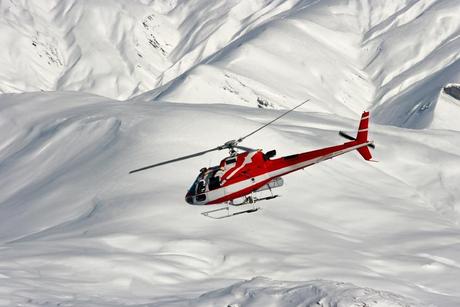
Imagine skiing on a pristine and fresh snow-covered mountain without waiting in long lines or constantly weaving through inexperienced skiers. Heli-skiing provides these opportunities and so much more. By using a helicopter to access peaks that would normally be unreachable, skiers can experience fresh powder, steep descents, natural contours and smooth corn snow. Experienced skiers usually find that traditional ski resorts only offer predictable terrain in non-ideal conditions. Heli-skiing is an exciting and adventurous antidote to typical resort skiing.
How It Works
Heli-skiing involves the transport of up to a dozen individuals from down-slope locations to mountain peaks in the nearby area. Skiers place their equipment in a basket on the exterior of the aircraft until they can safely disembark. Heli-skiers are accompanied by a guide who is familiar with the surrounding landscape, and has extensive experience in spotting both ideal and dangerous places to ski. Guides decide when skiers proceed down the slope and how many skiers go at a time. They are also responsible for giving specific commands in order to avoid serious dangers like crevassses, avalanche starting zones and serac falls.
Types of Conditions
There is a wide range of conditions to be encountered while heli-skiing, from effortless to extremely difficult. It’s important to have an expert guide that can spot specific conditions that are ideal for your group. A popular time of the year is during early winter. This is when a good amount of snow falls with cold enough temperatures to keep a powder surface. Others prefer to ski on the creamier snow that results from the longer and warmer days during spring, which also means more time to ski.
Skills Required
The most important skill required for heli-skiing is the ability to ski immediate and advanced level slopes. Novice skiers are highly advised to hone their skills in controlled resorts before adventuring on to very steep terrain encountered by heli-skiers. In Europe, heli-skiers are also expected to have skills in ski mountaineering. This skill involves the use of ropes, ice axes and other climbing equipment to ascend certain parts of the mountain. Skiers are also expected to be quick going down the mountain in order to maximize the number of runs that can be fit into a day; this requires good strength and fitness.
Equipment
Any equipment needed for a regular ski trip is also needed for heli-skiing, including gloves, hats, goggles and neck warmers. Bringing a backpack is an absolute necessity for carrying rescue gear in case of an avalanche. Of course, European heli-skiers also need to carry their ski-mountaineering equipment. As far as skis are concerned, the majority of heli-skiers use freeride, powder or all-mountain skis. These types of skis make it easier to descend more vertical feet by reducing stress on the legs. They are also easier to find in the snow when they fall off, decreasing the amount of recovery time during a fall. These wide skis also reduce the amount of injuries that occur in more dangerous skiing conditions.
